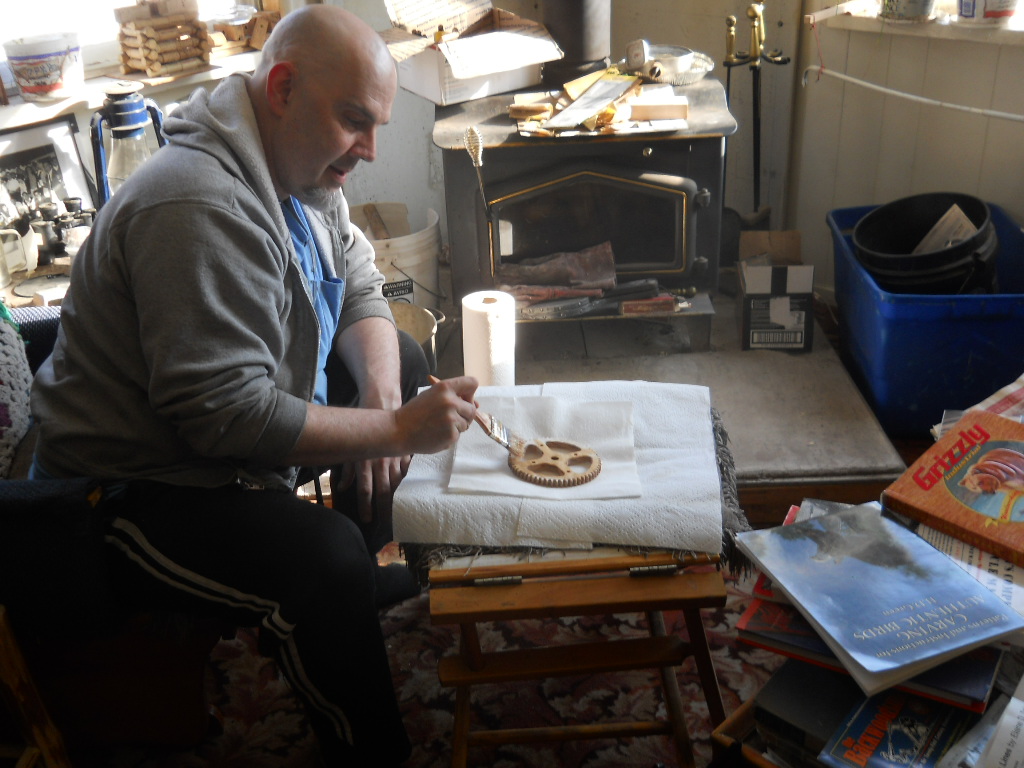If all there were to a clock (wooden or otherwise) were a bunch of gears with a weight (or spring) attached, then it is probably pretty obvious that the falling weight would just unwind the gear train at the proper rate for whatever weight you put on it. Minus friction. So how does a clock keep time? It has to have an
escape mechanism, clockspeak for a device that interrupts the weight on its Newton-ordained fall to the ground. The escape mechanism on a clock is usually, in a clock, based on a pendulum; since a pendulum of a given length gives you a very steady beat. But alas, there is
friction. You can easily make a pendulum. Put a weight on the end of a rod. Put it in some sort of pivot. A nail, say. Push it. You will see that eventually the pendulum beats no more. Friction, you see. So there is another function the escape mechanism must perform. It has to give a bit of a kick to the pendulum, to counter-act the evil friction. Actually, friction can be a Good Thing (TM) else your car wouldn't stop when you hit the brakes, but in clocks we really, really, don't like it. Again in clockspeak, the bit of a kick is called
impulsing the pendulum. Over the years, nay centuries, there have been numerous very clever humans who have designed escape mechanisms, as a Google search on "clock escape mechanisms" will convince you. Mine is what the designers of this clock deemed best, a "deadbeat escape mechanism". There are many others.
The basic escape mechanism consists of the
anchor and the
pallets.The anchor consists of a piece of wood. You can see the anchor very clearly in the pic above. It looks like an anchor! The pallets are pieces of brass. Resist wear, you see. It was fun making the pallets. I milled them on the lathe, but took no pictures because it was a very simple job. Then I filed to the required angles. Now I have to adjust them, but that will take time (it's a clock!) and I have postponed it. I moved on to that tedious job, the
minute work as it is called. The thing is, the clock is set up (all those gears!) so the
Center Wheel (one of the gears) revolves at 1/60 times a second, or in other words one minute. But there is an hour hand. It must go around the dial much slower than the minute hand. In fact it must go around 60 times slower. (assuming you have a 12-hour dial). More gears. That's what the minute work is for. Another gearbox. Now the wheels were cut out on a bandsaw by hand. Hardly precision work. Furthermore here are small imperfections caused by the fact that you did not drill the holes for the axles, or arbors, exactly where you should. So we have to
depth the gears (wheels). In this clock, says Mr Wilding, this involves sanding off bits from the teeth until the gears spin freely. At first I tried sandpaper. Very slow. I spent three days depthing the wheels. Then I got smart. I rigged up my lathe with it Dremel milling jig, which I described elsewhere.
The Dremel has a router bit in it. With this baby I can take off as little as .01 cm (or .0005") at one go from the wheel. (Not really. This is wood, not metal. Precision is futile). This speeded up the problem considerably. Couldn't have done this with the going train (the main gears) because the wheels are too big to "swing" on my little Taig. Later I got even smarter. But that's another post. Live and learn.






